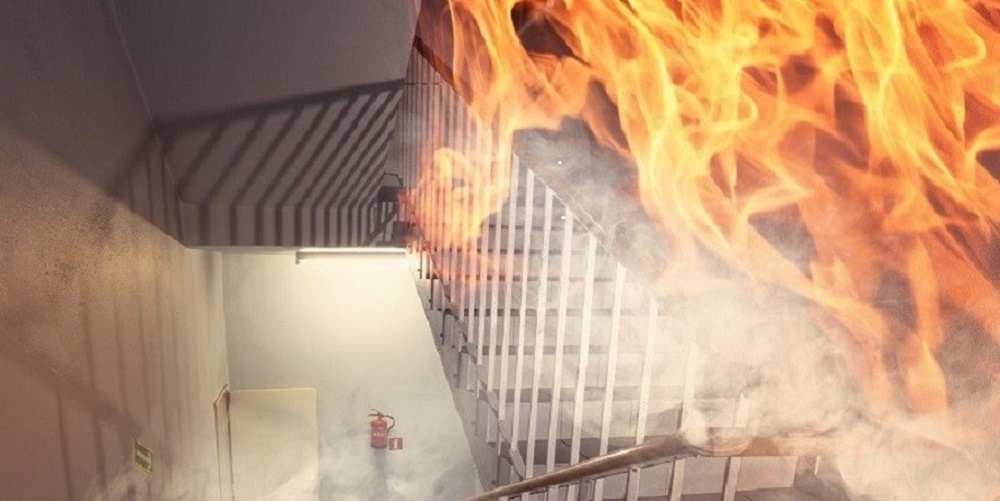Where There’s Smoke, There Had Better Be the Latest in Detection
Smoke and heat detectors save lives and mitigate property loss – know the factors to match the optimal device to the given application.

System designers need to consider various factors – from the environment within the occupancy and use of the occupancy to ceiling geometry, airflow, ceiling height and more. Image: ambrozinio/stock.adobe.com.
Fire can cause death and destruction of lives, property and mission. For people, injury or death can occur by means of thermal exposures that results in burns or by the inhalation of the products of combustion, smoke. A building can be severely damaged by both the results of heat from a fire, or by the deposits of smoke within the structure. The mission of a commercial business can be stopped or altered if a fire occurs.
This article reviews the means for the detection of heat and smoke. It is through the early detection of these two byproducts of a fire that lives, property and mission can be saved and damage from the same reduced.
Code & Design Considerations
The earliest form of detection was through heat detection. This method is still in use today. The second method is through the use of smoke detection. This discussion will not be comprehensive in reference to NFPA 72, Fire Alarm and Signaling Code. This set of standards has been in existence for more than 100 years in one form or another. This article will only refer to the 2022 edition. The National Fire Alarm Association is midway through the work for the 2025 edition.
Before diving into the forms of heat and smoke detection available today, a balanced approach to fire detection should always be considered. This is through the installation of a fire suppression system within the property to be protected. The Automatic Fire Alarm Association (AFAA) has worked with both the National Fire Sprinkler Association (NFSA) and American Fire Sprinkler Association (AFSA) in this regard.

A building can be severely damaged by both the results of heat from a fire, or by the deposits of smoke within the structure. The mission of a commercial business can be stopped or altered if a fire occurs. Image: pixel shot/stock.adobe.com.
While a fire alarm system through the use of both heat and smoke detection will alert occupants of a potential fire danger and allow them to exit the building, it will not extinguish the fire. A fire sprinkler system will control and possibly extinguish a fire, but by itself will not alert building occupants of a fire unless one is nearby the sounding device on the riser.
Unlike smoke detectors, heat detectors are not life-safety devices. If the intent of a system is for property or mission protection, then the 100% usage of a heat detector could serve toward that means. If the object of the fire alarm system is for life safety, then smoke detection is required to be used.
Before any design or installation work is to start, Chapter 17, Initiating Devices of NFPA 72 (2022) needs to be consulted. Without doing so could result in an improper final layout and the generation of unwanted alarms. Human behavior in regard to fire alarm signals tends to go on the assumption that the alarm must be false. It is not until the smell or sight of smoke or the sight of flames that a person begins to move. This is important to keep in mind as the designer of a fire detection system needs to account for the environment within the occupancy to be protected so unwanted alarms are not generated.
4 Types of Heat Detection
There are four means of heat detection in use today:
- Rate-of-rise
- Fixed
- Rate compensation
- Linear
A rate-of-rise detector will activate if there is a 10° change of temperature within a minute. This rapid change of temperature within a space could be an indication that a thermal event, such as a fire, has started. This change of temperate will cause the rate-of-rise detector to activate. While the rate-of-rise detector may be listed for 135° or 190° F, the rate-of-rise aspect of the detector will allow it to trip in a space that is only at 60° but rapidly goes to 70°, 80° or more during a very short time period. These detectors will restore if their listed rating is not reached or exceeded.
A fixed temperature detector will only activate when its listed rating has been reached. These detectors are more stable in certain environments than a rate-of-rise detector. It is possible in an attic or at the ceiling on an uninsulated warehouse to have a rise in temperature that would active a rate-of-rise detector. For these and similar environments, only a fixed temperature spot heat detector should be used. Within NFPA 72, there is a requirement that the rating of the detector shall be at least 20° above the ambient temperate at the ceiling.

The Response Time Index (RTI) of a detector is a quantitative means of determining the response time of the device per unit of time as a function of the ceiling jet velocity and time. Image: auremar/stock.adobe.com.
Both rate-of-rise and fixed temperature detectors are affected by thermal lag. This is the time it takes for the heat that is on the outside of the detector to each the inside of the detector. There are situations in which the detection of the heat from a fire needs to be detected as soon as possible. The first is to check the Response Time Index (RTI) of the detector. The RTI is a quantitative means of determining the response time of the detector per unit of time as a function of the ceiling jet velocity and time. All heat detectors manufactured after July 1, 2008, are required to have their RTI provided. The lower the published RTI for a heat detector, the faster its response time will be.
The other means for a more rapid activation is through the use of a rate compensation heat detector. This detector, through its design, compensates for thermal lag and will trip at when the rated temperature within the ceiling jet is reached, either through rate-of-rise or the listed temperature rating. This type of detector should be specified for such applications as elevator shut trip or, if due to the location of an elevator, a smoke detector should not be used within a particular elevator lobby (e.g. parking garage or external environment).
The detectors covered thus far are referred to as spot detectors. There are a number of locations in which a heat detector is required, but a spot-type detector will not serve the design requirements. In these cases, the designer should look at linear heat detection, in which the heat detector is part of the wiring conductor that is fed through the area to be protected. This may be in and around machinery, unique spaces within an occupancy, lumberyard cribs, barns and stables, construction sites and so forth. Depending on the type of linear detector that is being used, it may provide a trip if any part of the detector senses heat or be able to provide the location of the heat.
Ion vs. Photoelectric Smokes
There are two primary methods that smoke detectors have used for the detection of smoke, ion and photoelectric. Both of these means have been available for a number of years. While the use of photoelectric detectors has remained strong, ion detectors are not specified that often. For the past several years, additional methods of smoke detection have come into the market. These are combination detectors and multicriteria detectors. Smoke detectors also come as spot detectors, linear detectors and aspiration detectors.
Ion detectors have a very small amount of Americium 241. The Americium 241 changes the ion within the sensing chamber of to be positive and negative. A circuit is created within the sensing chamber. When the products of combustion enter the chamber, the flow of electrons is disrupted, breaking the circuit and causing the detector to go into an alarm state. Ion detectors work best for a flaming fire, in which there is very little visible smoke. They also tend to have a higher percentage of unwanted alarm activations.
Photoelectric detectors work by the percentage of smoke obscuration that may occur within the sensing chamber. When a predetermined percentage is reached, the detector will go into an alarm state. Photoelectric detectors work well with visible smoke and are the predominant smoke detectors that are in use today.
Care in the placement of any type of spot smoke detector is required. The designer and installer must be familiar with environmental factors that could generate an unwanted alarm, such as air vents, showers and cooking areas. Most smoke detectors also have issues with environments with high air velocities, dust and high moisture.

With addressable detectors, the exact location of the detectors is noted at the fire alarm control unit and this information can be transmitted to a supervising station. Image: auremar/stock.adobe.com.
A smoke detector may either be addressable or an analog addressable. Conventional detectors are also in use, typically on older systems. These may be two- or four-wire devices in which the power and signal are either on the same two conductors or the power and signal are on separate conductors. The trend for conventional detectors at this time is leaning toward the two-wire types. Heat detectors may also be addressable.
With addressable detectors, the exact location of the detectors is noted at the fire alarm control unit and this information can be transmitted to a supervising station. This allows the dispatch center to advise the responding fire department of the location within the protected premises of where the alarm is being generated from. In some cases, if the signaling line circuit is not damaged in a fire, it may be possible to track the progression of a fire’s growth through the location of the activated smoke detectors.
An analog detector may be adjusted for sensitivity, depending on the environment the detector is within. The detectors may also be programmed to be more sensitive at night when no one is within the protected property. This allows for a quicker response to smoke, while at the same time reducing the chances of generating a false alarm.
The trend for detectors, heat and smoke alike, appears to be moving toward wireless. The remaining restraints in that regard are power and battery life and a reliable radio frequency and/or path that can be used within an occupancy.
Additional Detector Options
For larger spaces, linear smoke detectors can be used. These are also known as smoke beams. They work on the same principle as photoelectric detectors, in which the level of smoke obscuration is measured by the detector through a light source (transmitter) and the receiver. When the level of smoke reaches a predetermined percentage, the detector will activate.
These detectors can be used in large warehouses, manufacturing plants, the atriums of a hotel or office buildings and large open spaces. The constraints to their use are that there must be a stable mounting surface for the transmitter, prism or transmitter/receiver. There also must be a clear line-of-sight pathway for the beam to get from the transmitter to the receiver. If a clear path is not provided, the device may be subject to unwanted alarms or a trouble condition if the pathway is totally blocked.
Smoke beams are very useful within a large atrium in which smoke stratification may come into play due to the height of the ceiling. In this case there may be several smoke beams installed at various levels within the space.
Aspiration detectors are another means of providing detection. There are now a number of manufacturers that provide such a solution in which a piping system is installed within the space to be protected. The air within the space is then drawn into the piping system and the level of smoke obscuration is measured. These can be a very sensitive means of detection in which a very small amount of smoke needs to be present to activate the detector. Spaces such as a datacenter or telephone switch room may use this method of detection. This method of detection may also be installed within cabinets and enclosures that contain critical equipment.
During the past several years, combination and multicriteria detectors have made their way into the market. A combination detector will be several detectors combined into one platform, with independent outputs for each method of detection (smoke, CO and heat). A multicriteria detector combines the signal from various sources and will activate when predetermined levels are reached, such as smoke obscuration, CO percentage or parts per million, CO2 percentage or parts per mission and heat. A multicriteria detector can be very stable yet very sensitive, providing a very early detection of an incipient fire.
In closing, the designer of a system needs to take into consideration the environment within the occupancy, the use of the occupancy, the geometry of the ceiling, the ambient temperature of the spaces to be protected, airflow, ceiling height and size of the space. From this information, the detector that would provide the best application should and needs to be selected.
If you enjoyed this article and want to receive more valuable industry content like this, click here to sign up for our FREE digital newsletters!

Security Is Our Business, Too
For professionals who recommend, buy and install all types of electronic security equipment, a free subscription to Commercial Integrator + Security Sales & Integration is like having a consultant on call. You’ll find an ideal balance of technology and business coverage, with installation tips and techniques for products and updates on how to add to your bottom line.
A FREE subscription to the top resource for security and integration industry will prove to be invaluable.














